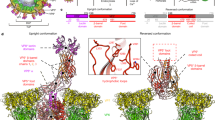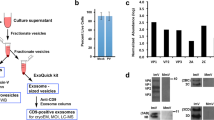Summary
In order to study the mechanism of entry of vaccinia virus into cells the fate of virion associated polypeptides was investigated during infection of african green monkey kidney (BSC-40) cells with 35 S-methionine labelled virus. Approximately 12–15 percent of the virion polypeptides were degraded to acid-soluble products by 3 hours post-infection. Proteolysis was inhibited (50 percent) by methylamine, suggesting a lysosomal site of degradation. Neither methylamine or chloroquine inhibited virus infectivity or uncoating indicating a non-acid endocytic mechanism of entry. Subcellular fractionation studies on density gradients indicated that the bulk of the input virion polypeptides were associated with the plasma membrane fraction. In addition, input virion DNA was partially resolved from the membrane fraction. The results are most consistent with a mechanism of entry involving fusion of the virus with the plasma membrane.
Similar content being viewed by others
References
Armstrong JA, Metz DH, Young MR (1973) The mode of entry of vaccinia virus into L cells. J Gen Virol 21: 533–537
Bablanian R, Coppola G, Scribani S, Esteban M (1981) Inhibition of protein synthesis by vaccinia virus. III. The effect of ultraviolet-irradiated virus on the inhibition of protein synthesis. Virology 112: 1–12
Baumann H, Hou E, Doyle D (1980) Insertion of biologically active membrane proteins from rat liver into plasma membrane of mouse fibroblasts. J Biol Chem 255: 10,001–10,012
Chang A, Metz DH (1976) Further investigations on the mode of entry of vaccinia virus into cells. J Gen Virol 32: 275–282
Dales S, Kajioka R (1964) The cycle of multiplication of vaccinia virus in Earle's strain L cells. I. Uptake and penetration. Virology 24: 278–294
Dales S, Pogo BGT (1981) Biology of poxviruses. In:Kingsbury DW, Zur Hausen H (eds) Virology monographs, vol 18. Springer, Wien New York
Esteban M (1984) Defective vaccinia virus particles in interferon-treated infected cells. Virology 133: 220–227
Helenius A, Marsh M, White J (1982) Inhibition of Semliki Forest virus penetration by lysosomotropic weak bases. J Gen Virol 58: 47–68
Ichihashi Y, Oie M (1980) Adsorption and penetration of the trypsinized vaccinia virion. Virology 101: 50–60
Janeczko RA, Etlinger JD (1984) Inhibition of intracellular proteolysis in muscle cultures by Multiplication Stimulating Activity. J Biol Chem 259: 6292–6297
Janeczko RA, Carriere RM, Etlinger JD (1985) Endocytosis, proteolysis and exocytosis of exogenous proteins by cultured myotubes. J Biol Chem 260: 7051–7058
Joklik WK (1962) The purification of four strains of poxviruses. Virology 18: 9–18
Marsh M, Bolzau E, Helenius A (1983) Penetration of Semliki Forest virus from acidic prelysosomal vacuoles. Cell 32: 931–940
Merion M, Poretz RD (1981) The resolution of two populations of lysosomal organelles containing endocytosedWistaria floribunda agglutinin from murine fibroblasts. J Supramol Struct Cell Biochem 17: 337–346
Merion M, Sly WS (1983) The role of intermediate vesicles in the adsorptive endocytosis and transport of ligand to lysosomes by human fibroblasts. J Cell Biol 96: 644–650
Moss B (1985) Replication of Poxviruses. In:Fields BN (ed) Virology. Raven Press, New York, pp 685–703
Rodriguez JF, Janeczko R, Esteban M (1985) Isolation and characterization of neutralizing monoclonal antibodies to vaccinia virus. J Virol 56: 352–356
Seglen PO (1983) Inhibitors of lysosomal function. Methods Enzymol 95: 737–764
Stern W, Dales S (1976) Biogenesis of vaccinia. Isolation and characterization of a surface component that elicits antibody suppressing infectivity and cell-cell fusion. Virology 75: 232–241
Tartakoff AM (1983) Perturbation of vesicular traffic with the carboxylic ionophore monensin. Cell 32: 1026–1028
White J, Matlin K, Helenius A (1981) Cell fusion by Semliki Forest virus, influenza and vesicular stomatitis virus. J Cell Biol 89: 674–679
White J, Killian M, Helenius A (1983) Membrane fusion proteins of enveloped animal viruses. Quart Rev Biophys 16: 151–195
Zaslavsky V (1985) Uncoating of vaccinia virus. J Virol 55: 352–356
Author information
Authors and Affiliations
Additional information
With 7 Figures
Rights and permissions
About this article
Cite this article
Janeczko, R.A., Rodriguez, J.F. & Esteban, M. Studies on the mechanism of entry of vaccinia virus in animal cells. Archives of Virology 92, 135–150 (1987). https://doi.org/10.1007/BF01310068
Received:
Accepted:
Issue Date:
DOI: https://doi.org/10.1007/BF01310068




